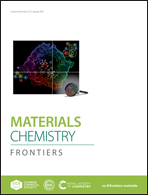Multicore–shell structured Ce–In2O3 for acetone detection by spray pyrolysis using NaCl as a high temperature auxiliary agent†
Abstract
In2O3 doped with Ce element was synthesized by a simple one-step spray pyrolysis method. In this method, NaCl was used as a high-temperature auxiliary agent and a template to synthesize multicore–shell structure samples. The spherical morphology and internal core–shell structure of the final synthesized sample were observed using a field emission electron microscope (FE-SEM) and a transmission electron microscope (TEM). Based on the X-ray photoelectron spectroscopy (XPS) analysis and O2 temperature programmed desorption (O2-TPD), the sensor doped with 5 mol% Ce (S3) presented the best oxygen adsorption capability. Device testing showed that the S3 sensor reached the highest response (53.47) to 100 ppm of acetone. Compared with the pristine In2O3, the operating temperature of the device was reduced to 220 °C, and the selectivity of the sensor improved. The introduction of Ce ions improved the ability of the host material to adsorb oxygen, thereby enhancing the sensor's ability to detect acetone. In addition, the formation mechanism of the sample and the gas mechanism are discussed in detail in the article.



 Please wait while we load your content...
Please wait while we load your content...